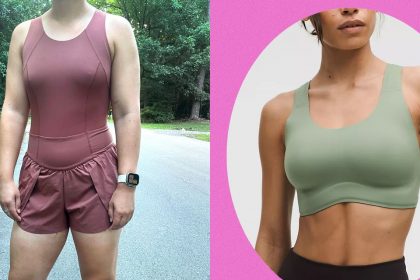If you’ve just started pounding the pavement, you probably had this thought cross your mind soon after lacing up: What does proper running form look like? Am I running “wrong”?!
Since you probably weren’t ever officially “taught” to run, like you would if you picked up another sport like, say, golf or skiing, you might be wondering if your natural gait is the correct one—and, if not, if the way you run might actually be setting you up for injury (or at the least, hampering your performance).
Surprisingly, though, there isn’t one “right” way to run. When researchers analyzed factors like stride length, how your foot hits the ground, and how long you stay off the ground, among other metrics, they still weren’t able to reach any firm conclusions about what makes for “good” running form, according to a 2024 review published in Sports Medicine. In fact, in most cases, it’s not something you should worry about dissecting or changing.
“If people are just getting out there to run and enjoy themselves, and they don’t have any issues, there’s no reason to look at your form,” physical therapist and run coach Kimberly Melvan, DPT, CSCS, tells SELF.
Still, there are some form tips to keep in mind that could help make things feel a little easier on the run. These can be especially helpful for folks who spend a lot of their day sedentary, sitting and hunching over their phones, physical therapist Emmi Aguillard, DPT, who treats and trains runners, tells SELF. Over time, that kind of posture can mess with your biomechanics and change the way you run, she says. And if you’re dealing with a nagging chronic injury, experts may recommend you try a few tweaks too.
While gait analysts’ recommendations are specific to each individual runner’s unique movement patterns, we asked the experts for some of the most common form cues that can help nearly anyone out there racking up the miles.
Gaze ahead.
Rather than looking down at the ground directly in front of you, or letting your head arch back, gaze straight ahead, physical therapist, run coach and running gait analyst Lisa Mitro, DPT tells SELF. Think about your chin just leading your chest, but not poking out so far that there’s a crease in your neck, she adds. This will help give you a more efficient posture (and avoid unwelcome neck pain). It’s the same reasoning behind the cue to “keep your neck neutral” when you’re performing strength training moves, like a row or a deadlift.
Keep your feet on their own tracks.
If you’ve got some weakness in your hips—particularly in that gluteus medius on the side of your butt—your feet might veer in toward your midline, cross over, or even hit each other with each stride. (If you’ve ever ended a run with scrapes or bruises along your inner ankle, this may be why.)
You really want each foot to stay in its own straight path, Dr. Melvan says. That’s why some coaches will tell runners to imagine keeping their feet on separate railroad tracks. “Or act like your kneecaps are headlights,” Dr. Melvan says. That can help to keep your knees pointing forward the way they’re meant to. (It’s not just about consciously watching your footpath here, though; strengthening your hips can help to straighten up your stride without you having to actively think about it—this workout can help!)
Adopt a (slight) forward lean.
Standing up straight is great for healthy posture in day-to-day life, but it isn’t doing you any favors on the road. One of the simplest ways to make running feel a little easier is to lean into your strides. “I always like to think of running as controlled falling,” Dr. Melvan says. Angling your body slightly forward (and we mean slight— up to five degrees or so) can help you harness some natural momentum thanks to the pull of gravity.
Just make sure you’re not leaning your torso so far that you can’t tap into the full power of your glutes. “It’s super common for runners to bend over when they’re running,” Dr. Mitro says. Other runners overcorrect by arching their back and flaring out the ribs, which leaves them unable to engage their core, Dr. Aguillard adds. To find the right position, Dr. Mitro suggests pretending like you’re running into the wind or running up a hill.
Speaking of which: It helps to keep leaning even when you are on a hill. Dr. Aguillard recommends pushing even further forward when you’re going uphill (so leaning into the hill). And don’t fight gravity on downhills. “Oftentimes people lean back,” she says. Unless you’re on a super steep incline where you need to brake for balance, leaning away from it will simply slow you down.
Drive your knees up and forward.
When you get tired running, it’s pretty common to end up shuffling your feet, barely picking them up off the ground. But Dr. Aguillard says we should actually make like the old Looney Tunes cartoon Road Runner. “You want to think of the legs as looking more like a wheel as you run,” she says. You can see this on elite runners—their lower legs circle underneath them rather than plod behind them. This circling motion gives you a more active push-off, and better engages the back of your legs and glutes.
One of the best ways to accomplish this (without overdoing it) is to think about driving your knees forward and up. This comes with a nifty bonus too: Focusing on your knee drive can also help to keep you from overstriding, or landing with your feet too far out in front of your body, which can slow you down and increase your risk of injury, Dr. Aguillard says. If you’re thinking about your knees leading your stride, you’re less likely to kick your foot out. “You want your foot to land close to under your hips,” Dr. Mitro says.
Let your arms propel you.
Your shoulders and hands should feel fairly loose, rather than hunched or tense, which can tire you out faster. “Everything needs to be relaxed with your arm swing,” Dr. Mitro says. Some coaches will even have you practice gently holding a potato chip while running so you don’t clench your fists.
Just make sure your arms are swinging front and back rather than side to side, which wastes energy. “When you swing your arms, the goal is to generate power and drive,” Dr. Aguillard says. She recommends thinking about slightly reaching forward—to better engage your core and promote that helpful forward lean—while driving the opposite elbow back.
Aim for a higher cadence.
Taking smaller, faster steps, a.k.a., increasing your cadence, can also help you avoid overstriding. One small 2021 study found that this strategy reduced runners’ peak impact forces, or how much stress went through their joints; the 2024 Sports Medicine concluded it slightly decreases how much energy runners use. Although some coaches tout 180 steps per minute as the ideal cadence, Dr. Aguillard says a more realistic goal is 170, and it’s best to work your way up there little by little—just focus on adding about five steps per minute at a time, then pushing for more once that’s comfortable.
To go about this, some runners will run to the beat of a metronome or a playlist designed around a target step rate. If you don’t like running with headphones, Dr. Melvan says even just thinking about running softer or more quietly can also help.
Focus on one cue at a time—and what your body needs to pull it off.
As helpful as all these form cues can be, trying to think about a whole bunch of them at once isn’t the best strategy. “It’s too awkward,” says Dr. Melvan. She says that we can end up throwing off our natural movement patterns when we totally overthink things—so it’s best to focus on one at a time.
And sometimes, it’s less about what we’re thinking about on the run and more about doing our cross-training homework outside of it. You may need to incorporate more running-specific strength training for your body to actually be able to pull off the form you’re after. Building proper stability and mobility can help support more efficient movement patterns so you may not even have to think about these cues.
Dr. Mitro adds that doing a few drills before your run can also help activate the right muscles and give you a feel for where your body should be. In particular, she loves hopping on a single leg while leaning into a wall or skipping to help you nail that forward lean. Then, Dr. Aguillard recommends doing four to 10 strides—20- to 30-second bursts of fast running—at the end of your warm-ups. That’s because when we run harder, we’re more likely to run with more efficient form. “That is a great way to connect all the dots,” she says.
But remember: Lots of our gait boils down to our individual anatomy.
Even if you make all these tweaks, your form still might not look the same as an elite runner’s—and that’s completely fine. All of our bodies are a little different. For instance, “the most efficient runners aren’t going to be overstriding. But ‘not overstriding’ is going to look different on everyone,” Dr. Mitro says. Proof: Researchers in that same 2024 Sports Medicine review concluded that trying to measure overstriding by calculating hip or knee angles wasn’t actually helpful—there are simply too many factors on all our various body shapes.
In some cases, trying to “fix” personal quirks can backfire. Take foot strike patterns, which you may notice we did not include here as one of our tips to keep in mind. That’s because researchers have found it doesn’t actually matter as much as people think.
“Some people will heel strike. Some people will run on their toes. Some people will land more midfoot. And even though that may look different, you can still be an efficient runner,” Dr. Mitro says. Injuries sometimes get blamed on particular foot strike patterns, but she says that when runners try to change theirs, they often just end up injuring something else. “The muscles and the tendons they’re using and the way they’re loading their joints, they’ve become adapted to doing it in that way,” Dr. Aguillard says. “If you were to tweak it, you’d be putting stress on a body part that just isn’t used to getting that much load.”
Not sure if it’s worth trying to change something? If you’re not experiencing pain or don’t feel like an inefficient gait is holding you back from your race goals, there’s no need to overcomplicate things, Dr. Melvan says. “If you just go out and run,” she says, “I think your body does a pretty good job of naturally falling into the rhythm that you should be in.”
Related:
- Do I Get a ‘Better’ Cardio Workout If I Go Faster or Longer?
- 12 Ways to Tell You’re Getting Better at Running That Aren’t All About Your Time
- The Moment I Actually Believed I Was a Runner, According to 14 Runners
Get more of SELF’s great fitness content delivered right to your inbox.







